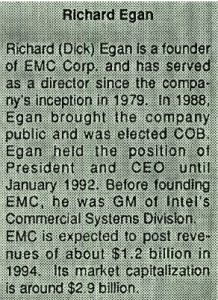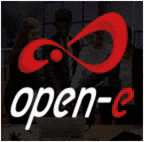History (1994): Exclusive Interview From EMC Chairman Dick Egan
"IBM Ramac hasn't seemed to slow down anything."
By Jean Jacques Maleval | January 25, 2021 at 2:21 pm![]() We met with Dick Egan, founder, COB, and former president and CEO of EMC Corp. (Hopkinton, MA) on the opening of a new 47,500 square foot extension of its European manufacturing plant in Cork, Ireland.
We met with Dick Egan, founder, COB, and former president and CEO of EMC Corp. (Hopkinton, MA) on the opening of a new 47,500 square foot extension of its European manufacturing plant in Cork, Ireland.

Storagenewsletter.com: What does EMC stand for?
Egan: EMC stands for “Egan’s Many Children.” No really, it’s Egan and (Roger) Marino. He was my partner.
How many members of your family are now employed by the company?
Right now, my wife, Maureen, is on the board of directors and my oldest son, John, is the EVP. Two of my sons help out once in awhile, adding assistance and consulting from time to time, but only 2 Egans work full-time.
(Maureen Egan’s brother, W. Paul Fitgerald, is CFO of EMC. According to an excellent article by Terry Lammers in Upside, September 1994, Dick Egan’s sister and son-in-law also hold small positions in the company. Ed.)
IBM said that your company is more marketing-oriented that product-oriented.
There’s a sign in everyone of our conference room that says: “It’s the product, stupid.” Do you remember when president Clinton was running for office. He used to have a sign: “It’s the economy, stupid.” It’s very complimentary of IBM to say we have good marketing, that’s a little misleading. but if they are saying we have good marketing because we don’t have good products, then that’s a little misleading. Our products are superior to anything IBM has made or is making in very aspect. They are faster, lower cost, more reliable, they take up less space, and they use less power and electricity. Now, if there’s a parameter by which you want to measure a product, let’s see what it is.
Why do I say that? Because that’s me talking. I don’t think there’s been a new customer who’s visited EMC Massachusetts or EMC Ireland in the last 6 to 9 months who hasn’t also visited IBM in San Jose. In fact, of most people getting off a plane in Boston, they come out to EMC and we get their order.
Now you know that in the last 6 to 9 months, IBM would have shown these customers everything. They would have opened up the kimono completely. But we got the orders. That’s why I’m drawing the conclusion that our Symmetrix system, which continues to get better and better every quarter, is a superior product to the Ramac.
It’s impossible for a company to be a success story all of its life. How do you imagine the end of this story?
When we went public in 1986, I went to the underwriters and I said: “Where’s the toughest place to go?” They replied it was New York and I said: “I want to go there first.”
What we have been doing as we grow is focusing on the engineering and the marketing, and tying them together on the markets. The mainframe, the mid-range, the OEM, and now the client/server. Manufacturing people have to make the products easy to sell, i.e. they have to get the salesman to sell their products. This is what I call the “Intel model.” I spent a number of years at Intel as a GM of one of the divisions and that’s the way Intel did it, and it worked well. Everybody felt it was their business, but they had to satisfy the salesmen, they had to satisfy the factory, and they had to make it easy to sell and profitable. That’s how I expect we will continue to grow the company without it becoming so big and difficult to manage.
What’s the percentage of your sales concerning the mainframe and the mid-range market?
More than 75% of our business is the mainframe, somewhere around 5% or 6% is the OEM, and the balance is the mid-range. Client/server has not even started.
And when do you see something like a 50%/50% between mainframe and client/server?
I don’t know when to predict that. I suspect that it’s a few years away. Just about every customer who comes back to Massachusetts, and I meet with a lot of them, is talking about client/server. About 20% of them have some plans, about 5% are actually doing something. So it’s moving a lot slower than the impression you get by reading the newspapers.
The 5% that are doing things are doing more in the area of new applications. So what we’re doing is, we’ve got the mainframe people working on client/server solutions, through Symmetrix with open systems in a basis. We have a clien/server division working on the Viper product that we will start shipping next month and we have the Epoch and Copernique people working on the data base management software, writing the software for the next client/server product that’s being designed in the US. And we have the mid-range people looking at – if you talk to an IBM RS/6000 salesman, he will say it is IBM’s open systems processing product, your client/server product. If you talk to the IBM AS/400 sales person, he’ll say this is it. If you talk to the mainframe person he’ll say this is it; so it’s a very amorphous subject. We think where ever it’s going, storage will be the most important part.
You have bought Array Technology, Copernique, and Epoch. Do you plan to continue acquisition and if so, which companies?
We didn’t acquire them for sales and revenue, we acquired them for specific technical expertise. I think we’ve rounded out the various technologies or technical expertises that we need.
Does IBM’s RAID Ramac announcement change anything in your company? And is the arrival of STK’s Iceberg changing anything?
The design for Iceberg was started a long time ago and some of the technology concepts that were employed there are probably not applicable. Remember the Ramac product is not yet shipped, so I wouldn’t like the image conveyed to the general public that it’s an existing product.
Yes, but does it affect the customer’s decision?
Oh yes, it could. But, it hasn’t seemed to slow anything down.
No?
Absolutely not. Mike Ruettgers, our president and CEO said it best, “It’s a snoozer.” I mean, for the last 6 to 9 months, I don’t know of one customer that hasn’t seen it before they came and bought Symmetrix. It’s curious to note that your main competitors are STK and IBM. The first is a customer and the other is one of your suppliers. We’re selling Storage Technology SSDs and also Epoch software. And we are buying some disk drives from IBM.
It is not difficult to deal with your competitors like that? That’s business! Will you ever have a RAID-5? We are already shipping RAID-5 in the mid-range. And the Symmetrix that are being shipped, I think starting next quarter, are RAID-5 upgradable.
Could you be more specific about Viper?
It’s designed to work in a heterogeneous environment, connectable to Sun workstations, RS/6000’s and HP 9000’s. Not yet AS/400, but of course we have that capability. It’s basically a probing product for the lower end of the client/server market. So we have the Symmetrix coming down. The Symmetrix that people are buying now are connectable to open systems. The Viper is coming up from the bottom.
Does this mean that Viper could be connected to a mainframe or to an open system?
We presently have Symmetrix systems connected to RS/6000’s, HP 9000’s, AS/400’s, Sun workstations simultaneously. We’re just not offering it for sale yet.
It’s not easy to convert data from IBM 3380 or 3390 drives to Unix environments. You can’t do it now.
Could Viper do that?
The machine is configurable. It is a very software-programmable system.
So you can migrate data from one platform to another?
We’re doing it now, but we’re not offering it for sale now because it’s not perfected yet. We’ve brought customers in, we’ve had them look at it, and they’ve been excited about it.
You are one of the 400 or 500 richest men In America, how do you spend all this money?
(The Egans’s own about 13% of total share outstanding, worth more than $480 million. Ed.)
I give it away.
For example?
I gave $6.7 million to Northeastern University, my alma mater, a couple months ago. We’re financing the Hopkinton Technology for Education Trust, where we’re introducing computers into the school system in our hometown. We started the Egan Family Foundation about 6 months ago, and that’s where you give the money and you get no benefit from it. You give it all to charity.
Have you invested In other companies?
No.
Are you on the board of directors of any other companies?
Nothing that’s a public company. I’m on the Board of Trustees of the Catholic Schools Foundation, the Massachusetts High Technology Council, and the American Island Fund.
This article is an abstract of news published on the former paper version of Computer Data Storage Newsletter on issue 79, published on August 1994.













 Subscribe to our free daily newsletter
Subscribe to our free daily newsletter

